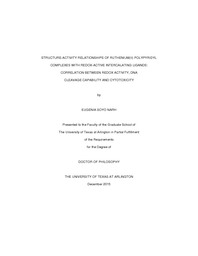
ATTENTION: The works hosted here are being migrated to a new repository that will consolidate resources, improve discoverability, and better show UTA's research impact on the global community. We will update authors as the migration progresses. Please see MavMatrix for more information.
Show simple item record
| dc.contributor.advisor | MacDonnell, Frederick M. | |
| dc.creator | Narh, Eugenia Soyo | |
| dc.date.accessioned | 2016-01-27T00:20:31Z | |
| dc.date.available | 2016-01-27T00:20:31Z | |
| dc.date.created | 2015-12 | |
| dc.date.issued | 2015-12-10 | |
| dc.date.submitted | December 2015 | |
| dc.identifier.uri | http://hdl.handle.net/10106/25481 | |
| dc.description.abstract | The investigation and development of transition metal complexes as cancer chemotherapeutics has gained a lot of interest in the past few decades and has become a promising area of research. Metal complexes of platinum and ruthenium in particular that have demonstrated success as anticancer drugs or are under exploration currently for clinical use are highlighted in Chapter 1.
Chapter 2 describes studies undertaken to understand the neurotoxicity of ruthenium(II) polypyridyl complexes (RPCs), including toxicity in mice and inhibition of the enzyme acetylcholinesterase (AChE), as previous work by Dwyer demonstrated that RPCs could be acutely toxic in mice, presumably due to their inhibition of AChE. Several ruthenium complexes were screened for their enzyme inhibitory potency which was correlated to their structural properties including size, charge, and lipophilicity. In addition, the inhibitory activity of the compounds was correlated to their animal toxicity data so as to understand the potential mode of action of the RPCs in vivo.
Chapter 3 describes the synthesis of a series of novel ruthenium(II) polypyridyl complexes and their characterization. These complexes were prepared in an effort to tune the reduction potential of the redox-active intercalating ligand (RAIL) to potentials slightly above and below those observed for the Ru-tatpp complexes. The redox activity of ruthenium-tatpp complexes appears to be responsible for their DNA cleavage activity and these analogues, with slightly different reduction potentials, should give us additional insight into the activity of this class of RPCs.
In Chapter 4, the electrochemical properties of the RPCs were measured and correlated with their ability to cause DNA cleavage under reducing conditions with GSH. Complexes with reduction potentials less (more positive) than the redox couple of GSH/GSSG were shown to efficiently cleave DNA. However complexes with higher reduction potentials than the biological reducing agent were not observed to cleave DNA under the same conditions. Cytotoxicity screening of these complexes in human non-small cell lung carcinoma cell lines (NSCLC – H358 and HOP-62) and breast adenocarcinoma cell line (MCF-7), as well as the non-malignant cell line (MCF-10) was performed and described in Chapter 4. | |
| dc.format.mimetype | application/pdf | |
| dc.language.iso | en_US | |
| dc.subject | Ruthenium (II) polypyridyl complexes | |
| dc.subject | Acetylcholinesterase inhibition | |
| dc.subject | DNA cleavage | |
| dc.subject | Reduction potential | |
| dc.subject | Redox activity | |
| dc.subject | Redox-active intercalating ligand | |
| dc.subject | Cytotoxicity | |
| dc.subject | Structure-activity relationships | |
| dc.subject | Anticancer activity | |
| dc.title | Structure-Activity Relationships of Ruthenium(II) Polypyridyl Complexes with Redox-Active Intercalating Ligands: Correlation between Redox Activity, DNA Cleavage Capability and Cytotoxicity | |
| dc.type | Thesis | |
| dc.date.updated | 2016-01-27T00:20:32Z | |
| thesis.degree.department | Chemistry and Biochemistry | |
| thesis.degree.grantor | The University of Texas at Arlington | |
| thesis.degree.level | Doctoral | |
| thesis.degree.name | Doctor of Philosophy in Chemistry | |
| dc.type.material | text | |
| dc.creator.orcid | 0000-0001-7511-7893 | |
Files in this item
- Name:
- NARH-DISSERTATION-2015.pdf
- Size:
- 2.632Mb
- Format:
- PDF
This item appears in the following Collection(s)
Show simple item record


